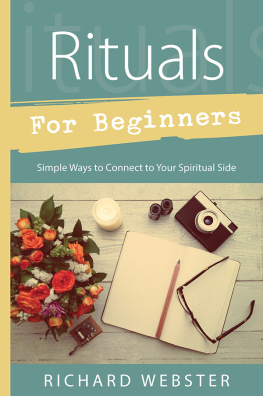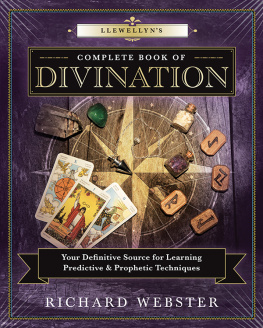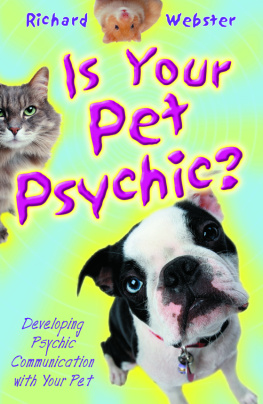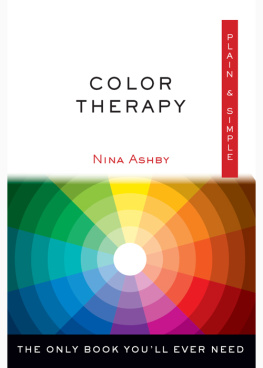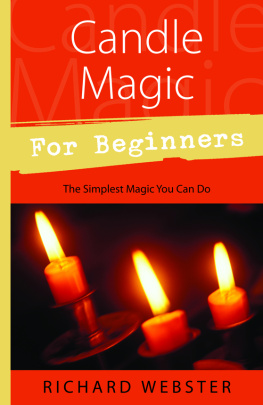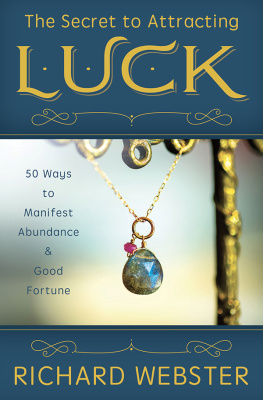

About the Author
Richard Webster is the author of over 75 books and one of New Zealands most prolific authors. His bestselling books include Spirit Guides & Angel Guardians and the new Creative Visualization for Beginners , and he is the author of Soul Mates, Is Your Pet Psychic?, Practical Guide to Past-Life Memories, Astral Travel for Beginners, Miracles , and the four-book series on archangels Michael, Gabriel, Raphael , and Uriel.
A noted psychic, Richard is a member of the National Guild of Hypnotherapists (USA), Association of Professional Hypnotherapists and Parapsychologists (UK), International Registry of Professional Hypnotherapists (Canada), and the Psychotherapy and Hypnotherapy Institute of New Zealand. When not touring, he resides in New Zealand with his wife and family.
Copyright Information
Color Magic For Beginners: Use the Power of Color to Attract Luck, Health & Harmony 2011 by Richard Webster
All rights reserved. No part of this book may be used or reproduced in any matter whatsoever, including Internet usage, without written permission from Llewellyn Publications, except in the form of brief quotations embodied in critical articles and reviews.
As the purchaser of this e-book, you are granted the non-exclusive, non-transferable right to access and read the text of this ebook on screen. The text may not be otherwise reproduced, transmitted, downloaded, or recorded on any other storage device in any form or by any means.
Any unauthorized usage of the text without express written permission of the publisher is a violation of the authors copyright and is illegal and punishable by law.
First e-book edition 2011
E-book ISBN: 978-0-7387-2456-0
Cover design by Adrienne Zimiga
Editing by Connie Hill
Llewellyn Publications is an imprint of Llewellyn Worldwide Ltd.
Llewellyn Publications does not participate in, endorse, or have any authority or responsibility concerning private business arrangements between our authors and the public.
Any Internet references contained in this work are current at publication time, but the publisher cannot guarantee that a specific reference will continue or be maintained. Please refer to the publishers website for links to current author websites.
Llewellyn Publications
Llewellyn Worldwide Ltd.
2143 Wooddale Drive
Woodbury, MN 55125
www.llewellyn.com
Manufactured in the United States of America
Dedication
For my granddaughter,
Ava Georgia Martin
Contents
Introduction
Some years ago, a friend invited me to see his new business premises. He had employed a color consultant to redecorate the building, and was hoping that it would improve productivity. It was fascinating to walk from room to room and feel the effects that different colors create.
Everyone is subliminally aware of the effects of certain colors. We all know that red, for instance, is stimulating and exciting. It is frequently used in fast food restaurants, as it encourages people to eat quickly and then leave, providing room for new customers. I was shy as a child and avoided the color red, as I instinctively knew it attracted attention. That was years before I learned that extroverts generally prefer the warmer colors, while introverts prefer the cooler shades.
The first time I appeared on television I was pleased to spend time in the green room beforehand. This is because green is a calming color that helps people to relax before appearing on the program.
One of my classrooms at high school was painted bright yellow, and I sometimes had headaches while attending lessons there. Yellow is a mentally stimulating color, but too much yellow can cause agitation and headaches.
I was interested in what my friend was trying to do, but found it sad that his only interest in color was in trying to increase productivity. Although he was not aware of it, he had done one positive thing for his employees. The factory walls had originally been painted blue, and his workers frequently complained about feeling cold. The walls were painted orange in the new color scheme, and everyone immediately felt warmer. Of course, this also benefited my friend, as it meant that everyone worked harder, as well.
We live in a world that is vibrant with color, yet most of the time we scarcely notice it. Heres an experiment. Look around the room you are in. See, really see, the color of the walls, furniture, carpet, and the clothes you are wearing. Each of these has an effect upon you, whether you are aware of it or not. You can change your mood and enhance your life by surrounding yourself with colors that are good for you.
Colors have three main aspects. They possess healing qualities. Consequently, color healing has been practiced for thousands of years. Colors also have a psychological effect on us that influences our minds and emotions. There is also an esoteric side to color. This can be utilized in color magic and to help encourage spiritual growth and development.
Most of the time, we are not really aware of the colors around us. After enjoying a pleasant walk, we probably return home feeling refreshed and invigorated, but are unlikely to think about the effects the different colors we saw created in us. It might be different if we choose to walk in a beautiful garden, but even then, we probably enjoy the different colors we see, but again take no notice of the effects they create in us. Every color has an effect on us. Red provides energy and enthusiasm. Green provides healing. Yellow enhances the intellect. Orange provides balance. Blue aids communication, and violet helps us make contact with our souls.
Everyone has color preferences, and children often ask their friends what their favorite colors are. Different systems of character analysis have been devised that use the subjects color preferences. Color clearly reveals our personalities, hopes and dreams.
Color has been used for healing purposes for at least 4,000 years. The ancient Egyptians had color-healing temples at Luxor and Heliopolis. Some people speculate that color healing is even older than that, and that priests in Atlantis were the first to use color-healing techniques.
Knowledge that light was essential to existence must have come extremely early in the history of mankind. Ancient hieroglyphics, jewelry and amulets clearly show the interest these people had in color. Color also had other associations. Around the world, people of different races gave colors to each of the cardinal directions.
In China, for instance, black was the color given to the north, while the south received red. East was green, and west was white. The Tibetans had the four-sided Sumur Mountain, which was home to their gods. The northern slopes of this mountain were given yellow, the southern blue, east white, and west red.
The people of ancient Greece and Rome believed that the world consisted of four elements: Fire, Earth, Air, and Water. Red symbolized Fire, blue symbolized Earth, yellow symbolized Air, and green symbolized Water. Josephus (c. 37100 C.E.), the Jewish historian, writer, and soldier, associated red with Fire, white with Earth, yellow with Air, and purple with Water. Nearly fifteen hundred years later, Leonardo da Vinci (14521519) associated red with Fire, yellow with Earth, blue with Air, and green with Water.
In the late nineteenth century, American ethnologist Alice Fletcher published a list of color meanings that she had learned from the Native Americans she was studying. Red symbolized the sun, stone, animal, and vegetable life, and the procreative force. White symbolized consecration. Blue symbolized wind, moon, water, thunder, lightning, and the West. Yellow symbolized sunlight.
Next page

